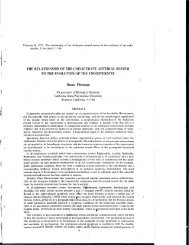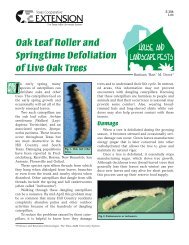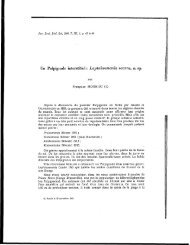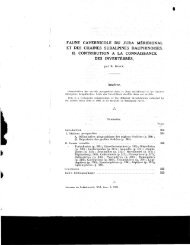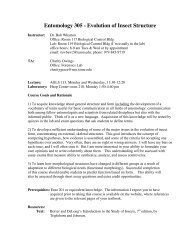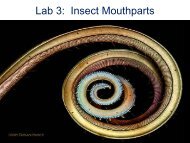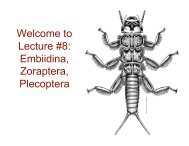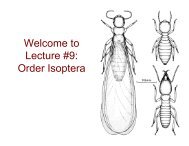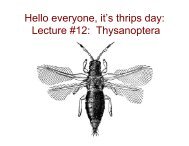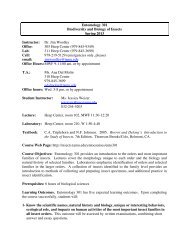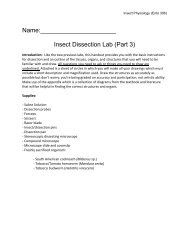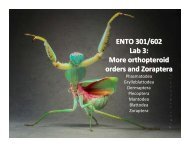ENTO 489 Swarming and Mating in Honey Bees Page 1 of 9 ...
ENTO 489 Swarming and Mating in Honey Bees Page 1 of 9 ...
ENTO 489 Swarming and Mating in Honey Bees Page 1 of 9 ...
Create successful ePaper yourself
Turn your PDF publications into a flip-book with our unique Google optimized e-Paper software.
<strong>ENTO</strong> <strong>489</strong><strong>Swarm<strong>in</strong>g</strong> <strong>and</strong> <strong>Mat<strong>in</strong>g</strong> <strong>in</strong> <strong>Honey</strong> <strong>Bees</strong>SWARMING• <strong>Swarm<strong>in</strong>g</strong> is probably the s<strong>in</strong>gle most significant management problem forbeekeepers everywhere, but one <strong>of</strong> the most spectacular events <strong>in</strong> nature towitness.• <strong>Swarm<strong>in</strong>g</strong> is colony-level reproduction. Dur<strong>in</strong>g this process a majority <strong>of</strong>workers <strong>and</strong> a queen leave the nest <strong>and</strong> form a cluster, from which they search for<strong>and</strong> eventually move to a new nest.SWARM• While it is certa<strong>in</strong>ly impressive to see thous<strong>and</strong>s <strong>of</strong> bees mov<strong>in</strong>g through the airwith a common purpose, a swarm is also a dishearten<strong>in</strong>g sight to the beekeeper.• <strong>Bees</strong> <strong>in</strong> airborne or clustered swarms are generally non-defensive <strong>and</strong> easilyh<strong>and</strong>led.WHY COLONIES SWARM• <strong>Swarm<strong>in</strong>g</strong> means that the colony has succeeded <strong>in</strong> reproduc<strong>in</strong>g. This is thepr<strong>in</strong>cipal goal <strong>of</strong> all colonies.• The pr<strong>in</strong>cipal goal <strong>in</strong> successful bee management is to create conditions that causebees to perceive that swarm<strong>in</strong>g has already occurred. Under those conditions, acolony will grow to an abnormally large size that can be managed to producesurplus honey, far beyond the colony’s average annual requirements.NATURAL HISTORY OF SWARMINGTemperate Climate:• In a temperate climate swarm<strong>in</strong>g preparation beg<strong>in</strong>s <strong>in</strong> the w<strong>in</strong>ter when coloniesfirst beg<strong>in</strong> to rear brood.• This brood is reared on the large stores that colonies entered w<strong>in</strong>ter. These beesreplace the old w<strong>in</strong>ter bees that experience a high mortality rate <strong>in</strong> the spr<strong>in</strong>g.Population plummets to a low po<strong>in</strong>t <strong>in</strong> March <strong>and</strong> gradually beg<strong>in</strong>s recover<strong>in</strong>g.• By April worker populations beg<strong>in</strong> a dramatic rise which climaxes <strong>in</strong> swarm<strong>in</strong>gsome time <strong>in</strong> May or early June.Tropical Climate:• There are usually two swarm<strong>in</strong>g seasons for tropically evolved bees liv<strong>in</strong>g <strong>in</strong> atropical climate. Typically <strong>in</strong> spr<strong>in</strong>g <strong>and</strong> fall colonies are able to produce swarms.Colonies may swarm 3 or 4 times dur<strong>in</strong>g an 8 month period with <strong>in</strong>tervals as shortas 50 days between prime swarms.• In French Guiana the reproductive rate <strong>of</strong> Africanized colonies is about 16 times.For European colonies <strong>in</strong> a temperate climate the maximum is only 3.6.<strong>Page</strong> 1 <strong>of</strong> 9
<strong>ENTO</strong> <strong>489</strong><strong>Swarm<strong>in</strong>g</strong> <strong>and</strong> <strong>Mat<strong>in</strong>g</strong> <strong>in</strong> <strong>Honey</strong> <strong>Bees</strong>• Brood rear<strong>in</strong>g is cont<strong>in</strong>uous <strong>in</strong> tropical climates.• Tropically evolved bees swarm at smaller colony sizes.• Texas is largely sub-tropical <strong>and</strong> the swarm<strong>in</strong>g habit <strong>of</strong> bees is somewherebetween temperate <strong>and</strong> tropical.FACTORS THAT INDUCE SWARMING1. Colony size.2. Brood nest congestion.3. Worker age distribution.4. Reduced transmission <strong>of</strong> queen substances.RESOURCE ABUNDANCEDependent on resource abundance.Dependent on colony size <strong>and</strong> cavity space.• Resource abundance largely affects colony size, brood nest congestion, <strong>and</strong>worker age distribution.• It may also be a prime stimulus <strong>of</strong> queen cell rear<strong>in</strong>g.SWARMING PREPARATION• Populations <strong>of</strong> feral (unmanaged <strong>and</strong> natural) colonies range from a m<strong>in</strong>imum <strong>of</strong>10,000 adults <strong>in</strong> late w<strong>in</strong>ter to a maximum <strong>of</strong> 40,000 <strong>in</strong> late spr<strong>in</strong>g, just prior toswarm<strong>in</strong>g.• Direct preparations for swarm<strong>in</strong>g beg<strong>in</strong> about 2 to 4 weeks before the swarmissues, dur<strong>in</strong>g a period when colonies are becom<strong>in</strong>g congested because <strong>of</strong> theworker population’s rapid growth.QUEEN PHEROMONE REGULATION OF SWARMING• Queens produce a pheromone from their m<strong>and</strong>ibular gl<strong>and</strong>s called QMP.• It functions as a releaser <strong>and</strong> a primer pheromone.• As a releaser pheromone it elicits ret<strong>in</strong>ue response.• As a primer pheromone it INHIBITS workers from <strong>in</strong>itiat<strong>in</strong>g queen rear<strong>in</strong>g.• Ret<strong>in</strong>ue behavior functions to distribute QMP throughout the nest.• QMP <strong>in</strong>forms workers a queen is present <strong>and</strong> <strong>in</strong>hibits them from queen rear<strong>in</strong>g.• As colonies grow to swarm<strong>in</strong>g size the distribution <strong>of</strong> QMP is reduced because <strong>of</strong>colony congestion <strong>and</strong> the amount <strong>of</strong> QMP reach<strong>in</strong>g <strong>in</strong>dividuals is decreased dueto a dilution factor.• The <strong>in</strong>hibitory effects <strong>of</strong> QMP on queen rear<strong>in</strong>g are reduced queen rear<strong>in</strong>g beg<strong>in</strong>s.• In this way queen rear<strong>in</strong>g occurs <strong>in</strong> the presence <strong>of</strong> a queen.<strong>Page</strong> 2 <strong>of</strong> 9
<strong>ENTO</strong> <strong>489</strong><strong>Swarm<strong>in</strong>g</strong> <strong>and</strong> <strong>Mat<strong>in</strong>g</strong> <strong>in</strong> <strong>Honey</strong> <strong>Bees</strong>TIMING OF SWARMING• Colonies most commonly swarm the day <strong>of</strong> or a day after seal<strong>in</strong>g the first queencell, usually 8-10 days after queen rear<strong>in</strong>g commences.• By swarm<strong>in</strong>g at or after queen cell seal<strong>in</strong>g, colonies are ensured <strong>of</strong> hav<strong>in</strong>g at leastone virg<strong>in</strong> queen emerge after swarm<strong>in</strong>g.• Weather <strong>and</strong> <strong>in</strong>ternal colony conditions can dramatically alter the tim<strong>in</strong>g <strong>of</strong>swarm<strong>in</strong>g, so colonies may swarm when very young larvae are present <strong>in</strong> queencells or after an adult virg<strong>in</strong> queen has emerged.• Queen cell destruction prior to swarm<strong>in</strong>g delays the issu<strong>in</strong>g <strong>of</strong> the first swarm fora few days, a delay that can improve the chances <strong>of</strong> swarm or parental colonysurvival.SUMMARY OF MAJOR SWARM CONTROL METHODS• For swarm<strong>in</strong>g to succeed colonies musttime their swarm<strong>in</strong>g efforts to co<strong>in</strong>cidewith a period <strong>of</strong> growth <strong>in</strong> the adultpopulation <strong>and</strong> the presence <strong>of</strong> enoughbrood to compensate for the loss <strong>of</strong>adults to the swarm.• Queen rear<strong>in</strong>g for swarm<strong>in</strong>g beg<strong>in</strong>swhen worker brood rear<strong>in</strong>g is at its peak,<strong>and</strong> there are no unoccupied cells <strong>in</strong> thebrood nest area.The biological basis <strong>of</strong> swarm control methods is to relieve colony congestion by:1. Add more space. That means stack another super on the hive. (Rule <strong>of</strong> thumb:“When <strong>in</strong> doubt, super.”)2. Revers<strong>in</strong>g the brood chambers. Colonies tend to move up but not spread down.The bottom brood chamber is <strong>of</strong>ten sparsely occupied <strong>in</strong> the spr<strong>in</strong>g compared tothe top. Simply revers<strong>in</strong>g their positions effectively adds more space for thequeen to lay eggs <strong>and</strong> bees to move <strong>in</strong>to.3. Divid<strong>in</strong>g a large colony <strong>in</strong> half or more.SUMMER MANAGEMENT PROCEDURES• The honey produc<strong>in</strong>g beekeeper wants to maximize colony adult population justprior to the major honey flow.• Requeen weak colonies.• Equalize colonies?• Check for diseases <strong>and</strong> parasites. Do not harvest honey from colonies that mustbe treated with chemicals.<strong>Page</strong> 4 <strong>of</strong> 9
<strong>ENTO</strong> <strong>489</strong><strong>Swarm<strong>in</strong>g</strong> <strong>and</strong> <strong>Mat<strong>in</strong>g</strong> <strong>in</strong> <strong>Honey</strong> <strong>Bees</strong>• Check food stores.• Cont<strong>in</strong>ue with swarm prevention measures if necessary.• Add honey supers or frames as necessaryPREPARATIONS FOR SWARMINGOld queen loses weight so she can fly.• About a week prior to swarm<strong>in</strong>g colonies feed their queen less food.o Reduces egg lay<strong>in</strong>g rate.o Queen’s abdomen reduces <strong>in</strong> weight due to dim<strong>in</strong>ished feed<strong>in</strong>g rate.• Reduced weight enables the queen to fly.• Workers “exercise” the queen by shak<strong>in</strong>g, push<strong>in</strong>g, <strong>and</strong> even bit<strong>in</strong>g the queen tokeep her mov<strong>in</strong>g.SWARMING• A few days prior to swarm<strong>in</strong>g colonies are very calm.• On the day <strong>of</strong> swarm<strong>in</strong>g the calm is broken <strong>and</strong> colonies erupt <strong>in</strong>to a k<strong>in</strong>d <strong>of</strong>chaotic frenzy that leads to swarm<strong>in</strong>g.• In general, swarms issue <strong>in</strong> late morn<strong>in</strong>g or early afternoon, however weatherconditions largely affect the time <strong>of</strong> swarm<strong>in</strong>g so that swarm<strong>in</strong>g may occur anytime dur<strong>in</strong>g daylight hours.• Because the tim<strong>in</strong>g is so unpredictable, even for the colony, workers will beengorged with honey for about 10 days prior to swarm<strong>in</strong>g to ensure the swarmwill have sufficient reserves to <strong>in</strong>itiate a new nest.• All workers, those that swarm <strong>and</strong> those that stay beh<strong>in</strong>d, will be engorged withhoney, carry<strong>in</strong>g about 3.6 times more honey <strong>in</strong> their stomachs than non-swarm<strong>in</strong>gworkers.• Workers suddenly change their behavior hours prior to swarm<strong>in</strong>g.• DVAV dances suddenly drop <strong>and</strong> workers run back <strong>and</strong> forth <strong>in</strong> waves, buzz<strong>in</strong>gto excite other workers (rem<strong>in</strong>iscent to the buzz runs used to stimulate the rest<strong>in</strong>gswarm to re-launch).• The queen is chased, bitten, <strong>and</strong> pulled along with excited workers.• A group <strong>of</strong> workers issue from the nest entrance, usually tak<strong>in</strong>g the queen withthem, <strong>and</strong> take flight.• “False swarms” may issue where the queen is not driven out or she re-enters thenest. When this happens the cluster <strong>of</strong> workers usually return to the colony.• If the queen jo<strong>in</strong>s the extra-colony cluster any bees fly<strong>in</strong>g outside the colonyusually jo<strong>in</strong> the queen cluster <strong>and</strong> a prime swarm has formed.<strong>Page</strong> 5 <strong>of</strong> 9
<strong>ENTO</strong> <strong>489</strong><strong>Swarm<strong>in</strong>g</strong> <strong>and</strong> <strong>Mat<strong>in</strong>g</strong> <strong>in</strong> <strong>Honey</strong> <strong>Bees</strong>• Subsequent swarms that issue with a queen are called “afterswarms”.SUPERSEDURE OR QUEEN REPLACEMENT: ANOTHER FORM OF REPRODUCTION.• In addition to queen rear<strong>in</strong>g <strong>in</strong> preparation for swarm<strong>in</strong>g, supersedure is thesecond social context <strong>in</strong> which queen rear<strong>in</strong>g occurs <strong>in</strong> the presence <strong>of</strong> a queen.• No swarm is produced. Colonies supersede the old mothers queen to replace herwith a new sister queen.• Diseased, <strong>in</strong>jured <strong>and</strong> old queens are most frequently superseded.• It is a common misconception that old queens have reduced or changedpheromone production that acts as a cue for supersedure. This has not beenproven. Old queens are not produc<strong>in</strong>g a different blend or amount <strong>of</strong> pheromonescompared to young queens. Other more direct cues are likely function<strong>in</strong>g.WHO WILL REIN• Colonies rear multiple queens at one time, yet only one will be the colony queen.Usually more than 6 <strong>and</strong> up to 40 swarm cells.• Neither workers nor queens tolerate more than one queen.• Once swarm<strong>in</strong>g is completed, emerged queens attempt to kill queens not yetemerged by cutt<strong>in</strong>g small holes <strong>in</strong>to queen cells <strong>and</strong> st<strong>in</strong>g<strong>in</strong>g the occupants.• Workers will destroy disturbed queen cells whether occupants have been stung ornot.• When two virg<strong>in</strong> queens meet they fight to the death. Injured queens are <strong>of</strong>tenkilled by workers.WHO WILL REINQUEEN FIGHTS• Fight<strong>in</strong>g queens st<strong>in</strong>g <strong>and</strong> bite each other.• Workers participate <strong>in</strong> fights by form<strong>in</strong>g tight clusters around a queen, <strong>of</strong>tenreferred to as a ball. The ball <strong>of</strong> bees surround<strong>in</strong>g a queen may be protective orantagonistic.• Only one queen rema<strong>in</strong>s alive <strong>in</strong> the nest.• From the <strong>in</strong>itiation <strong>of</strong> queen rear<strong>in</strong>g until the new queen beg<strong>in</strong>s egg lay<strong>in</strong>g isabout 4 weeks.• This is the ma<strong>in</strong> reason most beekeepers purchase mated queens from queenbreeders rather than let colonies re-queen themselves.MATING1. Although a newly emerged queen is a fully developed reproductive female, shemust mate to atta<strong>in</strong> the reproductive capability <strong>of</strong> a colony queen.<strong>Page</strong> 6 <strong>of</strong> 9
<strong>ENTO</strong> <strong>489</strong><strong>Swarm<strong>in</strong>g</strong> <strong>and</strong> <strong>Mat<strong>in</strong>g</strong> <strong>in</strong> <strong>Honey</strong> <strong>Bees</strong>2. <strong>Mat<strong>in</strong>g</strong> must occur for a queen to be able to lay fertilized, diploid eggs that willdevelop <strong>in</strong>to workers.3. The usual period between emergence <strong>and</strong> mat<strong>in</strong>g around 5 to 8 days.4. The <strong>in</strong>terval between emergence <strong>and</strong> egg lay<strong>in</strong>g (oviposition) ranges from 9 to 15days. Some queens may lay earlier <strong>and</strong> some later than the normal range.5. The queen’s impulse to mate is strong when she is 6 or 7 days old <strong>and</strong> she willtake mat<strong>in</strong>g flights from any cluster <strong>of</strong> bees that is organized as a colony.QUEEN MATING BEHAVIOR• Most queens take 1 or 2 orientation flights prior to tak<strong>in</strong>g a mat<strong>in</strong>g flight.• In general queens may take 2 to 5 mat<strong>in</strong>g flights.• Orientation <strong>and</strong> mat<strong>in</strong>g flights take place <strong>in</strong> a 2 to 4 day period <strong>in</strong> good weather.• Temperatures must be above 20º C (68º F) <strong>and</strong> w<strong>in</strong>ds less than 20-28 kph (12-17mph).• Queen mat<strong>in</strong>g can be delayed for up to 4 weeks after emergence if weatherdoesn’t permit mat<strong>in</strong>g, but beyond that they beg<strong>in</strong> to lay drone eggs.DRONES• Drone rear<strong>in</strong>g generally peaks about 4 weeks prior to swarm<strong>in</strong>g.• Drones emerge <strong>and</strong> are mature before virg<strong>in</strong> queens are available for mat<strong>in</strong>g.• It is highly unlikely <strong>and</strong> genetically undesirable for drones <strong>and</strong> queens from thesame colony to mate.• Colonies generally produce more drones than queens.• The number <strong>of</strong> drones reared is determ<strong>in</strong>ed by 1) the amount <strong>of</strong> available dronecomb, <strong>and</strong> 2) colony population.• Drones are fed by workers for the first few days <strong>of</strong> adult life. They will graduallybeg<strong>in</strong> to feed themselves from honey cells.• Drones beg<strong>in</strong> orientation flights at about 8 days after emergence while stillsexually immature.• Drones are sexually mature around 12 days after emergence. <strong>Mat<strong>in</strong>g</strong> flights, <strong>of</strong>longer duration than orientation flights, occur when drones are sexually mature.CONGREGATION AREAS• <strong>Mat<strong>in</strong>g</strong> occurs <strong>in</strong> congregation areas, discrete aerial sites where drones fly,anticipat<strong>in</strong>g the arrival <strong>of</strong> queens.<strong>Page</strong> 7 <strong>of</strong> 9
<strong>ENTO</strong> <strong>489</strong><strong>Swarm<strong>in</strong>g</strong> <strong>and</strong> <strong>Mat<strong>in</strong>g</strong> <strong>in</strong> <strong>Honey</strong> <strong>Bees</strong>• We know very little about congregation areas beyond the fact that they exists.• What we know is a result <strong>of</strong> the discovery that a tethered or caged queens or ODAattracts drones <strong>and</strong> the use <strong>of</strong> high-speed film record<strong>in</strong>g.• In apicultural sett<strong>in</strong>gs congregation areas are not usually found any closer than 90to 120 m from the apiary site.• <strong>Mat<strong>in</strong>g</strong> occurs <strong>in</strong> the air 15 to 30 m above the ground.• Drones fly back <strong>and</strong> forth through the area wait<strong>in</strong>g for queens. Sometimescongregation areas are detected by the audible hum, much like a swarm’s.MATING• When a queen arrives the “lazy” flight <strong>of</strong> drones patroll<strong>in</strong>g the congregation areachanges dramatically.• Sometimes a “comet-shaped” pattern <strong>of</strong> drones is observed pursu<strong>in</strong>g a queen.• Chemical <strong>and</strong> visual cues are used by drones to detect a queen.AERIAL MATING• Mount<strong>in</strong>g <strong>and</strong> copulation are rapid <strong>and</strong> difficult to observe.• The drone approaches from below the queen.• With<strong>in</strong> a split second the drone mounts the queen grasp<strong>in</strong>gher with all 6 legs <strong>and</strong> everts his endophallus <strong>in</strong>to the queen’sopen st<strong>in</strong>g chamber.• Endophallus eversion is a reflex response. He is paralyzed<strong>and</strong> flips backwards, at which po<strong>in</strong>t an explosive ejaculationoccurs that is sometime audible.<strong>Mat<strong>in</strong>g</strong> sign.• Actual mat<strong>in</strong>g usually lasts less than 5 sec <strong>and</strong> <strong>of</strong>ten no more than 1 or 2 sec.MATING• After mat<strong>in</strong>g the drone dies.• On average a s<strong>in</strong>gle drone can contribute about 8 millionsperm.• All sperm <strong>of</strong> a s<strong>in</strong>gle drone is not necessarily taken up<strong>in</strong>to a queen’s spermatheca.• The endophallus rema<strong>in</strong>s <strong>in</strong> the queen but doesn’t prevent further mat<strong>in</strong>gs.• Subsequent mates remove the endophallus <strong>of</strong> the previous drone.<strong>Page</strong> 8 <strong>of</strong> 9
<strong>ENTO</strong> <strong>489</strong><strong>Swarm<strong>in</strong>g</strong> <strong>and</strong> <strong>Mat<strong>in</strong>g</strong> <strong>in</strong> <strong>Honey</strong> <strong>Bees</strong>• The queen returns to the colony with the endophallus <strong>of</strong> the last drone <strong>in</strong> her st<strong>in</strong>gchamber. This is called a mat<strong>in</strong>g sign.MATING FREQUENCY• Queens may take up to 3 mat<strong>in</strong>g flights.• The probability <strong>of</strong> <strong>in</strong>creas<strong>in</strong>g mat<strong>in</strong>g numberdoes not significantly <strong>in</strong>crease from 2 to 3mat<strong>in</strong>g flights.• Extreme number <strong>of</strong> mates may occur bychance alone rather than queen mat<strong>in</strong>g flightfrequency.From Tarpy <strong>and</strong> <strong>Page</strong> 2001 Ann Zool Fennici 38: 255-265.• To significantly decrease the probability <strong>of</strong> aqueen mat<strong>in</strong>g with a drone that shares thesame sex allele as a queen the queen needsto mate with at least 5 drones.• One mat<strong>in</strong>g flight results <strong>in</strong> an average <strong>of</strong> 5mates (previous slide).• Two mat<strong>in</strong>g flights usually ensure morethan 5 mates <strong>and</strong> thus the probability <strong>of</strong>sufficient GENETIC VARIABILITYnecessary for a healthy colony.From Tarpy <strong>and</strong> <strong>Page</strong> 2001 Ann Zool Fennici 38: 255-265.<strong>Page</strong> 9 <strong>of</strong> 9



